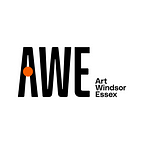How to Write an Artist Statement
Written by Sophie Hinch, Education & Public Programs Coordinator at The Art Gallery of Windsor
Creating a new work of art can come naturally. But explaining it to someone — that can be a challenge! An artist statement is a brief description of your art practice that helps the viewer better understand the meaning behind your work, and it can be just as important as the work itself. Here are a few things to consider and questions to keep in mind when writing your own artist statement.
Make It Personal
If you’re not sure where to start, start by interviewing yourself! Create a mind map or word cloud and write down what comes to mind about your work. Here are a few questions to get you started: Who is your audience? What is the purpose of your work? Who are your influences? Sources of inspiration? How do you make your work and with what materials? How do your materials inform your process? What colours do you use and why? Do your life experiences influence your work? What symbols do you use and why? Why do you make what you make? Listen to your gut and be honest — you already know the answers!
Build A Strong Structure
The opening sentence should be direct and captivating. Start with a short paragraph with a description of your artistic style and overall vision. What are you trying to say with your art? Your next paragraph should clearly outline your artistic process. Highlight your tools and materials, and what inspires your practice. Lastly, finish your statement by briefly explaining how your new work fits with your current body of work.
Keep It Short: Less Is More
A good artist statement is usually between 150 and 200 words — think of it as an elevator pitch for your work! The average gallery visitor spends about 17 seconds looking at a work of art. Your artist statement should grab the reader’s interest with the first sentence. You want your text to be short enough that the reader will get all the important information in that period of time. Be clear, concise, and honest.
Be Specific, But Not Too Specific
Use simple and accessible language. Some artists use technical and specific jargon that may not be understood by the reader. Your audience may not be art historians, professors, or artists, so you want to write your statement like you’re talking to someone who may have little to no understanding of the art world. Make sure the content is not too complicated or technical. You want to draw your audience in, not push them away.
Write In An Active Voice
Using an active voice keeps your work in the present, making it feel like it’s happening now rather than in the past. An artist statement should also always be written in the first person. You won’t always be standing next to your work to explain it, so imagine that your statement is having a conversation with the viewer. Make sure that it clearly communicates your unique point of view.
Last But Not Least: Proofread
And be sure to proofread more than once! Read it out loud, or record it on your phone and listen to it. Ask friends or family members to proofread your work for spelling errors and clarity. Make sure at least one of your proofreaders is not an artist or does not know your work — readers should be able to understand your statement without knowing all the terms or references.
As you continue to grow, evolve, and create new works, make sure to revisit and edit your artist statement as needed. Happy writing!
